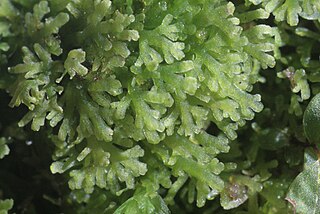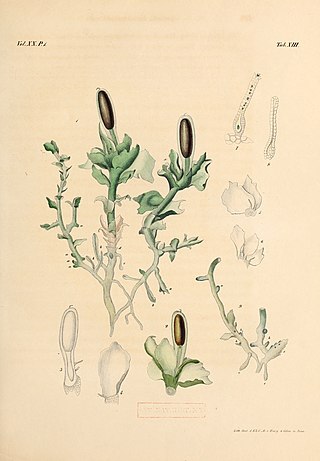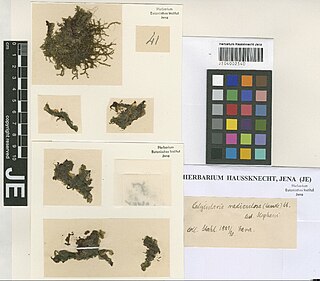
The Marchantiophyta are a division of non-vascular land plants commonly referred to as hepatics or liverworts. Like mosses and hornworts, they have a gametophyte-dominant life cycle, in which cells of the plant carry only a single set of genetic information.

Barthélemy Charles Joseph Dumortier was a Belgian who conducted a parallel career of botanist and Member of Parliament.

Marchantiales is an order of thallose liverworts that includes species like Marchantia polymorpha, a widespread plant often found beside rivers, and Lunularia cruciata, a common and often troublesome weed in moist, temperate gardens and greenhouses.

Lunularia is a genus of liverworts whose only species is Lunularia cruciata, the crescent-cup liverwort. Lunularia is either the only genus in the order Lunulariales, or may be placed in the order Marchantiales. The name, from Latin luna, moon, refers to the moon-shaped gemma cups.

Metzgeriales is an order of liverworts. The group is sometimes called the simple thalloid liverworts: "thalloid" because the members lack structures resembling stems or leaves, and "simple" because their tissues are thin and relatively undifferentiated. All species in the order have a small gametophyte stage and a smaller, relatively short-lived, spore-bearing stage. Although these plants are almost entirely restricted to regions with high humidity or readily available moisture, the group as a whole is widely distributed, and occurs on every continent except Antarctica.

Sphaerocarpales is an order of plants within the liverworts. Approximately twenty species are in this order which is sub-divided into four families: Monocarpaceae, Sphaerocarpaceae and Riellaceae, as well as the extinct family Naiaditaceae. The inclusion of the Naiaditaceae is uncertain, and the family has sometimes been assigned to the Calobryales.

Sphaerocarpos is a genus of plants known as bottle liverworts. There are eight or nine species in this genus.
Noteroclada is a small genus of liverworts of the Southern Hemisphere. It is classified in order Pelliales and is the only genus in the family Noterocladaceae within that order. Unlike Pellia, the other genus in the order, Noteroclada has a leafy appearance.

Lepidozia is a genus of liverwort in the family Lepidoziaceae. It was first proposed by Dumortier in 1835.
Sphaerocarpos drewiae is a species of liverwort in the family Sphaerocarpaceae. It is endemic to California, where it is known from San Diego and Riverside Counties. Its common name is bottle liverwort.

Haplomitriopsida is a newly recognized class of liverworts comprising fifteen species in three genera. Recent cladistic analyses of nuclear, mitochondrial, and plastid gene sequences place this monophyletic group as the basal sister group to all other liverworts. The group thus provides a unique insight into the early evolution of liverworts in particular and of land plants in general.
Apotreubia is a genus of liverworts in the family Treubiaceae. There are four species, including: Apotreubia nana, which is found in subalpine New Guinea, and Apotreubia pusilla, which has a disjunct distribution between eastern Asia and British Columbia.

Phyllothallia is a small genus of liverworts of the Southern Hemisphere. It is classified in the order Pallaviciniales and is the only member of the family Phyllothalliaceae within that order. Unlike most members of the Metzgeriales, Phyllothallia has a leafy appearance. The genus has a disjunct distribution, with the species Phyllothallia nivicola found in New Zealand while the other species in the genus, Phyllothallia fuegiana, occurs in Tierra del Fuego.

Sandeothallus is a small genus of liverworts restricted to East Asia. It is classified in the order of Pallaviciniales and is the only member of the family, Sandeothallaceae within that order.
Allisonia cockaynei is the only species of liverwort in the genus Allisonia and family Allisoniaceae. It is endemic to New Zealand.

Makinoa crispata is the only species of liverwort in the genus Makinoa and family Makinoaceae. The genus Verdoornia was formerly included in this family, but has been transferred to the family Aneuraceae on the basis of recent cladistic analysis of genetic sequences.

Pleurozia is the only genus of liverworts in the family Pleuroziaceae, which is now classified in its own order Pleuroziales, but was previously included in a broader circumscription of the Jungermanniales. The genus includes twelve species, and as a whole is both physically distinctive and widely distributed.

Ptilidium is a genus of liverwort, and is the only genus in family Ptilidiaceae. It includes only three species: Ptilidium californicum, Ptilidium ciliare, and Ptilidium pulcherrimum. The genus is distributed throughout the arctic and subarctic, with disjunct populations in New Zealand and Tierra del Fuego. Molecular analysis suggests that the genus has few close relatives and diverged from other leafy liverworts early in their evolution.

Sphaerocarpos texanus, the Texas balloonwort, is a species of liverwort in the Sphaerocarpaceae family, found in the Americas, northern Africa and Europe.
Petalophyllum, or petalwort, is a genus of liverworts in the order Fossombroniales.














